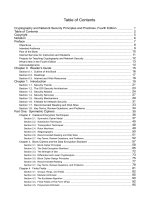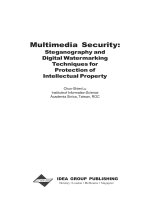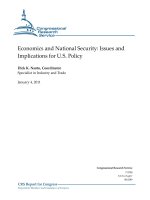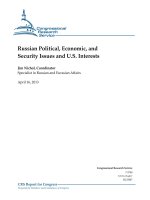Web security, SSL and TLS
Bạn đang xem bản rút gọn của tài liệu. Xem và tải ngay bản đầy đủ của tài liệu tại đây (96.73 KB, 30 trang )
Web security:
SSL and TLS
2
What are SSL and TLS?
SSL – Secure Socket Layer
TLS – Transport Layer Security
both provide a secure transport connection between
applications (e.g., a web server and a browser)
SSL was developed by Netscape
SSL version 3.0 has been implemented in many web browsers
(e.g., Netscape Navigator and MS Internet Explorer) and web
servers and widely used on the Internet
SSL v3.0 was specified in an Internet Draft (1996)
it evolved into TLS specified in RFC 2246
TLS can be viewed as SSL v3.1
3
SSL architecture
SSL Record Protocol
SSL Record Protocol
SSL
Handshake
Protocol
SSL
Handshake
Protocol
SSL Change
Cipher Spec
Protocol
SSL Change
Cipher Spec
Protocol
SSL
Alert
Protocol
SSL
Alert
Protocol
applications
(e.g., HTTP)
applications
(e.g., HTTP)
TCP
TCP
IP
IP
4
SSL components
SSL Handshake Protocol
–
negotiation of security algorithms and parameters
–
key exchange
–
server authentication and optionally client authentication
SSL Record Protocol
–
fragmentation
–
compression
–
message authentication and integrity protection
–
encryption
SSL Alert Protocol
–
error messages (fatal alerts and warnings)
SSL Change Cipher Spec Protocol
–
a single message that indicates the end of the SSL handshake
5
Sessions and connections
an SSL session is an association between a client and a server
sessions are stateful; the session state includes security
algorithms and parameters
a session may include multiple secure connections between
the same client and server
connections of the same session share the session state
sessions are used to avoid expensive negotiation of new
security parameters for each connection
there may be multiple simultaneous sessions between the
same two parties, but this feature is not used in practice
Sessions and connections
6
Session and connection states
session state
–
session identifier
•
arbitrary byte sequence chosen by the server to identify the session
–
peer certificate
•
X509 certificate of the peer
•
may be null
–
compression method
–
cipher spec
•
bulk data encryption algorithm (e.g., null, DES, 3DES, …)
•
MAC algorithm (e.g., MD5, SHA-1)
•
cryptographic attributes (e.g., hash size, IV size, …)
–
master secret
•
48-byte secret shared between the client and the server
–
is resumable
•
a flag indicating whether the session can be used to initiate new connections
–
connection states
Sessions and connections
7
Session and connection states cont’d
connection state
–
server and client random
•
random byte sequences chosen by the server and the client for every connection
–
server write MAC secret
•
secret key used in MAC operations on data sent by the server
–
client write MAC secret
•
secret key used in MAC operations on data sent by the client
–
server write key
•
secret encryption key for data encrypted by the server
–
client write key
•
secret encryption key for data encrypted by the client
–
initialization vectors
•
an IV is maintained for each encryption key if CBC mode is used
•
initialized by the SSL Handshake Protocol
•
final ciphertext block from each record is used as IV with the following record
–
sending and receiving sequence numbers
•
sequence numbers are 64 bits long
•
reset to zero after each Change Cipher Spec message
Sessions and connections
8
State changes
operating state
–
currently used state
pending state
–
state to be used
–
built using the current state
operating state pending state
–
at the transmission and reception of a Change Cipher Spec message
party A
(client or server)
party B
(server or client)
the sending part of the
pending state is copied
into the sending part
of the operating state
the receiving part of the
pending state is copied
into the receiving part
of the operating state
C
h
a
n
g
e
C
i
p
h
e
r
S
p
e
c
Sessions and connections
9
SSL Record Protocol – processing overview
MAC
application data
paddingtype
fragmentation
compression
msg authentication and
encryption (with padding if necessary)
version length
type version length
type version length
SSLPlaintext
SSLCompressed
SSLCiphertext
SSL Record Protocol
10
Header
type
–
the higher level protocol used to process the enclosed fragment
–
possible types:
•
change_cipher_spec
•
alert
•
handshake
•
application_data
version
–
SSL version, currently 3.0
length
–
length (in bytes) of the enclosed fragment or compressed fragment
–
max value is 2
14
+ 2048
SSL Record Protocol
11
MAC
MAC = hash( MAC_write_secret | pad_2 |
hash( MAC_write_secret | pad_1 | seq_num | type | length | fragment ) )
similar to HMAC but the pads are concatenated
supported hash functions:
–
MD5
–
SHA-1
pad_1 is 0x36 repeated 48 times (MD5) or 40 times (SHA-1)
pad_2 is 0x5C repeated 48 times (MD5) or 40 times (SHA-1)
SSL Record Protocol
12
Encryption
supported algorithms
–
block ciphers (in CBC mode)
•
RC2_40
•
DES_40
•
DES_56
•
3DES_168
•
IDEA_128
•
Fortezza_80
–
stream ciphers
•
RC4_40
•
RC4_128
if a block cipher is used, than padding is applied
–
last byte of the padding is the padding length
SSL Record Protocol









